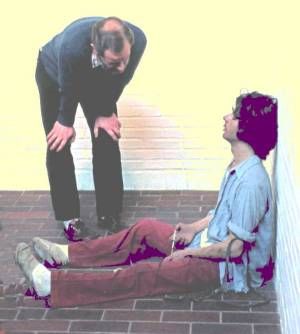 Low Dose Naltrexone (LDN)
Low Dose Naltrexone (LDN)by Jeffrey Dach MD
Imagine a drug addict slumped over from a lethal heroin overdose. He has shallow breathing and will die unless he receives prompt medical care in the emergency room. If he is lucky enough to make the trip to the ER, the doctors will give him an IV injection of Narcan (Naloxone), the drug of choice to reverse narcotics overdose, waking the victim and snatching him from the jaws of death.
Left Image: Duane Hanson's sculpture "Drug Addict" from 1974, Courtesy of wikipedia. The addict sitting the floor is a sculpture in a musem. The man standing is an anonymous museum visitor. (18)

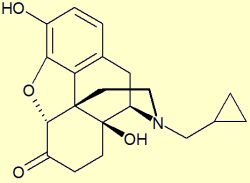

Chemical Structures of Naloxone, Naltrexone and Morphine are similar (see above three diagrams).
Naloxone (Narcan) Naltrexone Morphine
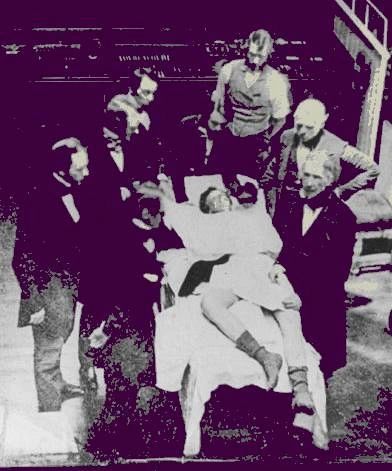
Narcan is available in the hospital operating room where anesthesiologists use it to wake up the patient after the operation. (image at left: first use of anesthesia). Opiate antagonists such as Narcan reverse the sedating effect of opiates by binding to the opioid receptors in the brain.
Left Image: First operation under ether anesthesia on October 16, 1846 (21) Courtesy Library of Congress.
Naltrexone was synthesized in 1963 and FDA approved since 1984. Naltrexone is a close chemical cousin to Narcan with very similar chemical structure, and is used to treat narcotics and alcohol addiction. (see chemical structure diagrams above). It was a surprise for me to find out that Naltrexone has other very important uses at a much lower dosage as an oral capsule. Medical scientists have been carefully studying its effect of Naltrexone on the immune system, and its clinical benefits for a host of disease states for the past 20 years.
The beneficial effect of low dose naltrexone, LDN, was discovered by Bernard Bihari, MD (1)(1A), a physician in New York City who found that a small dose (3 mg) of naltrexone taken as a capsule at bedtime blocks the opiate receptors in the brain for a few hours during sleep, which then stimulates the brain to increase production of endorphins over the next 24 hours. These endorphins then stimulate the immune system. Although Bihari did much of the early clinical work, Zagon did much of the groundwork with animal research studies at Pennsylvania State University (3-17).
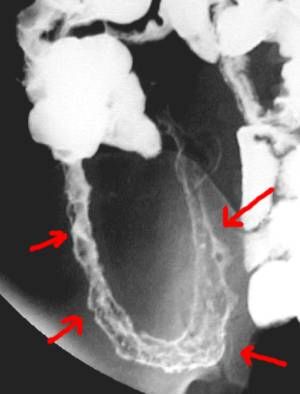 A recent publication in the Jan 2007 Journal of Gasteroenterology on the use of LDN in Crohn's Disease, was the first breakthrough publication to appear entitled, Low-Dose Naltrexone Therapy Improves Active Crohn's Disease by Jill Smith MD.
A recent publication in the Jan 2007 Journal of Gasteroenterology on the use of LDN in Crohn's Disease, was the first breakthrough publication to appear entitled, Low-Dose Naltrexone Therapy Improves Active Crohn's Disease by Jill Smith MD.Left Image: Typical appearance of Crohn's disease involving terminal ilem with ulcerations noted on barium small bowel examination (red arrows) . Courtesy of Jeffrey Dach MD, private collection.
Crohn's disease is a severe inflammatory condition of the small bowel which can be difficult to treat. Not difficult for LDN however. Jill Smith, M.D. reported that two-thirds of her 17 Crohn's patients went into remission, and 90% of the group had some benefit. Her article showed impressive colonoscopy photos before and after LDN treatment with complete clearing of the inflammatory changes in the bowel mucosa. Dr. Smith concluded that "LDN therapy appears effective and safe in subjects with active Crohn's disease."(2)
The major therapeutic action of LDN is the restoration of normal endorphin production by the brain. This is beneficial for any condition in which there is a deficiency in endorphin production, such as autoimmune disease, cancer and HIV/AIDS. Bernard Bihari, MD, who discovered the LDN protocol has used it in hundred of patients in the following categories:
LDN is useful for cancers of the Bladder, Breast, Colon & Rectal Cancer , Glioblastoma, Lung Cancer (Non-Small Cell), Lymphocytic Leukemia (chronic), Lymphoma Hodgkin's and Non-Hodgkin's) Malignant Melanoma, Multiple Myeloma , Ovarian Cancer, Pancreatic Cancer, Prostate Cancer (untreated), Renal Cell Carcinoma, Uterine Cancer,
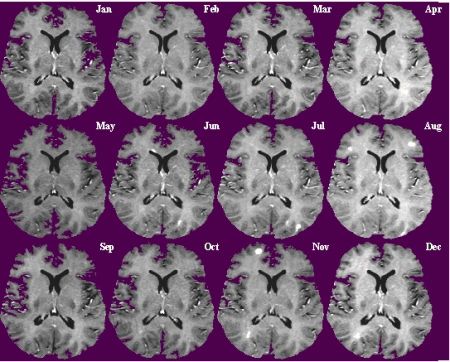
Image: Monthly MRI Scans of Multiple Sclerosis, small bright spots come and go, courtesy wikipedia.
LDN treatment has benefited these diseases: ALS (Lou Gehrig's Disease), Autism Spectrum Disorders, Chronic Fatigue Syndrome, Crohn's Disease, Fibromyalgia, HIV/AIDS, Multiple Sclerosis (MS), Parkinson's Disease, Psoriasis, Rheumatoid Arthritis, Scleroderma, Systemic Lupus (SLE), Ulcerative Colitis, Wegener's Granulomatosis.
LDN Has Virtually No Side Effects:
Occasionally, during the first week's use of LDN, patients may complain of some difficulty sleeping. This rarely persists after the first week. Should it do so, dosage can be reduced from 4.5mg to 3mg nightly.
Because LDN blocks opioid receptors throughout the body for three or four hours, people using narcotics pain pills such as Ultram (tramadol), morphine, Percocet, Duragesic, Oxycontin or codeine, should not take LDN until after complete withdrawal from their narcotic drugs. The use of LDN may induce narcotics withdrawal.
Although naltrexone is FDA approved, the LDN protocol is what is called "off-label use", and it is unlikely that any company will spend the millions needed to fund studies for FDA approval of the LDN protocol. However, off-label use of an FDA approved drug such as naltrexone is commonplace and widely accepted. The naltrexone capsules are inexpensive, about 20 dollars a month. The treatment is safe, with no adverse side effects.
Pharmacies that offer compounded LDN capsules:
The Compounder Pharmacy 340 Marshall Ave Unit 100, Aurora, IL 60506-2956 Phone: 630-859-0333 Fax: 630-859-0114. (22)
Skip's Pharmacy 21000 Boca Rio Rd Suite A-29 Boca Raton, Florida 33433, telephone 561-218-0111 800-553-7429 Fax: 561-218-8873 (24)
Thanks to Larry Frieders, the Compounder for bringing LDN to my attention, and for making low cost LDN capsules available to the public. (22)
Articles with related Content:
LDN Part Two (second part to this article)
Jeffrey Dach MD
7450 Griffin Rd Suite 180/190
Davie, FL 33314
Phone: 954-792-4663
Blog
References:
(1) http://www.ldninfo.org/index.htm
Web site for low dose nalotrexone information.
(1A) http://www.ldninfo.org/bbihari_cv.htm
Curriculum Vitae, BERNARD BIHARI, M.D. 29 West 15th Street New York, N.Y. 10011, (212) 929-4196 retired as of March 2007.
(2) http://www.ncbi.nlm.nih.gov/pubmed/17222320
Low-dose naltrexone therapy improves active Crohn's disease.Smith JP, Stock H, Bingaman S, Mauger D, Rogosnitzky M, Zagon IS. Am J Gastroenterol. 2007 Apr;102(4):820-8. Department of Medicine, Pennsylvania State University College of Medicine, Hershey, Pennsylvania 17033, USA.
OBJECTIVES: Endogenous opioids and opioid antagonists have been shown to play a role in healing and repair of tissues. In an open-labeled pilot prospective trial, the safety and efficacy of low-dose naltrexone (LDN), an opioid antagonist, were tested in patients with active Crohn's disease. METHODS: Eligible subjects with histologically and endoscopically confirmed active Crohn's disease activity index (CDAI) score of 220-450 were enrolled in a study using 4.5 mg naltrexone/day. Infliximab was not allowed for a minimum of 8 wk prior to study initiation. Other therapy for Crohn's disease that was at a stable dose for 4 wk prior to enrollment was continued at the same doses. Patients completed the inflammatory bowel disease questionnaire (IBDQ) and the short-form (SF-36) quality of life surveys and CDAI scores were assessed pretreatment, every 4 wk on therapy and 4 wk after completion of the study drug. Drug was administered by mouth each evening for a 12-wk period. RESULTS: Seventeen patients with a mean CDAI score of 356 +/- 27 were enrolled. CDAI scores decreased significantly (P= 0.01) with LDN, and remained lower than baseline 4 wk after completing therapy. Eighty-nine percent of patients exhibited a response to therapy and 67% achieved a remission (P < 0.001). Improvement was recorded in both quality of life surveys with LDN compared with baseline. No laboratory abnormalities were noted. The most common side effect was sleep disturbances, occurring in seven patients. CONCLUSIONS: LDN therapy appears effective and safe in subjects with active Crohn's disease. Further studies are needed to explore the use of this compound.
(3) http://www.ncbi.nlm.nih.gov/pubmed/6640516
Cancer Lett. 1983 Nov;21(1):89-94. Opioid antagonists inhibit the growth of metastatic murine neuroblastoma.Zagon IS, McLaughlin PJ.
Naltrexone (NTX), an opiate antagonist, had an inhibitory effect on the growth of S20 Y neuroblastoma in A/Jax mice. Daily injections of 0.1 mg/kg NTX resulted in a 69% tumor take, 70% delay in time prior to tumor appearance, and a 60% increase in median survival time. Inoculation of NB in control mice resulted in 100% tumor take within 15 days. The pattern and incidence of metastases of NTX and control mice were similar. These results show that NTX has antineoplastic activity, and suggests a role for the endogenous opioid system in neuro-oncogenic events.
(4) http://www.ncbi.nlm.nih.gov/pubmed/6316064
Life Sci. 1983 Dec 12;33(24):2449-54.
Naltrexone modulates growth in infant rats.Zagon IS, McLaughlin PJ.
Naltrexone, a potent opiate antagonist, had both stimulatory and inhibitory effects on somatic growth in preweaning rats depending on dose. Daily injections of 50 mg/kg naltrexone, which blocked morphine-induced analgesia for 24 hr/day, resulted in increased body and organ weights, and acceleration in the appearance of physical characteristics and maturation of spontaneous motor activity. Naltrexone in a dosage of 1 mg/kg, which blocked morphine-induced analgesia for 4 hr/day, had the opposite effects. These results show that naltrexone can modulate growth, and suggest a role for the endorphins and opiate receptors in developmental events.
(5) http://www.ncbi.nlm.nih.gov/pubmed/10592296
Brain Res. 1999 Dec 4;849(1-2):147-54. Cloning, sequencing, expression and function of a cDNA encoding a receptor for the opioid growth factor, [Met(5)]enkephalin.
Zagon IS, Verderame MF, Allen SS, McLaughlin PJ. Department of Neuroscience, The Pennsylvania State University, College of Medicine, 500 University Drive, Hershey, PA, USA.
The native opioid growth factor (OGF), [Met(5)]enkephalin, is a tonic inhibitory peptide that modulates cell proliferation and tissue organization during development, cancer, cellular renewal, wound healing and angiogenesis. OGF action is mediated by a receptor mechanism. We have cloned and sequenced a 2.1-kilobase (kb) cDNA for a receptor to OGF (OGFr). The open reading frame was found to encode a protein of 580 amino acids, and eight imperfect repeats of nine amino acids each were a prominent feature. The protein encoded by this cDNA exhibited the pharmacological, temporal and spatial characteristics of the OGFr. Functional studies using antisense technology demonstrated an enhancement in cell growth. The molecular organization of the OGFr has no homology to classical opioid receptors. These results provide molecular validity for the interaction of OGF and OGFr in the regulation of growth processes.
(6) http://www.ncbi.nlm.nih.gov/pubmed/11029512
Opioid growth factor regulates the cell cycle of human neoplasias.Zagon IS, Roesener CD, Verderame MF, Ohlsson-Wilhelm BM, Levin RJ, McLaughlin PJ.
Department of Neuroscience and Anatomy, H-109, The Pennsylvania State University, College of Medicine, Hershey, PA 17033, USA.
The native opioid growth factor (OGF), [Met5]-enkephalin, is a tonic inhibitory peptide that modulates cell proliferation and migration, as well as tissue organization, during development, cancer, homeostatic cellular renewal, wound healing, and angiogenesis. OGF action is mediated by the OGF receptor (OGFr). To investigate the target of OGF as to cell proliferation, the effects of excess OGF, and a deprivation of OGF-OGFr interaction by an opioid antagonist, naltrexone (NTX), were examined in 3 human cancer cell lines: pancreatic (BxPC-3), colon (HT-29), and head and neck (CAL-27). OGF exposure decreased growth, DNA synthesis, and mitosis, and increased the doubling time from control levels. FACS analysis revealed a marked increase in cells in the G0/G1 phase and compensatory reduction in cells in S and G2/M phases. Consistent with this observation, the percentage of labeled mitosis (PLM) analysis showed a notable increase in the time of the G0/G1 phase. Receptor blockade with NTX increased the rate of growth, length of DNA synthesis and mitotic phases, and decreased doubling time from control values. FACS analysis indicated an increase in the proportion of cells in S and G2/M phases, and a decrease in the number of cells in the G0/G1 phase. PLM evaluation demonstrated a shortening of the length of the S and G2 phases in the 3 cell lines, and decreases in the M and G0/G1 phases in some cancers. These results indicate that OGF action is directed at the G0/G1 phase, but interruption of OGF-OGFr interfacing has widespread repercussions on the cell cycle. The data on blockade of OGF-OGFr during log phase growth suggest a requisite escorting of the growth peptide and its receptor through the cell cycle.
(7) http://www.ncbi.nlm.nih.gov/pubmed/8620464
Cancer Lett. 1996 Mar 29;101(2):159-64.
Inhibition of human colon cancer by intermittent opioid receptor blockade with naltrexone.Hytrek SD, McLaughlin PJ, Lang CM, Zagon IS.
Nude mice inoculated with human colon cancer (HT-29) and receiving 0.1 mg/kg naltrexone (NTX) beginning immediately after tumor cell injection exhibited a marked retardation in tumorigenicity. This dosage of NTX, which blocked opioid receptors for 6-8 h/day, resulted in a delay of 2.4-fold in tumor appearance compared to control subjects. At the time (10 days) when all control mice had tumors, 80% of the mice in the 0.1 mg/kg NTX group had no signs of neoplasia. Binding capacity, but not affinity, of [3H][Met5]-enkephalin was reduced 85% of control levels in tumor tissue from mice of the 0.1 NTX group. Plasma, but not tumor tissue levels of [Met5]-enkephalin were elevated (2.5-fold) in contrast to control values. These results suggest that daily intermittent opioid receptor blockade with NTX provokes the interaction of opioids and receptors in the interval following drug availability, with opioids serving to inhibit tumorigenicity of human colon cancer.
(8) http://www.ncbi.nlm.nih.gov/pubmed/9066724
Cancer Lett. 1997 Jan 30;112(2):167-75. Opioid growth factor (OGF) inhibits human pancreatic cancer transplanted into nude mice.Zagon IS, Hytrek SD, Smith JP, McLaughlin PJ.
Nude mice inoculated with human pancreatic cancer (BxPC-3) cells and receiving 5 mg/kg of opioid growth factor ([Met5]enkephalin; OGF) three times daily exhibited a marked retardation in tumorigenicity compared to animals injected with sterile water (controls). OGF-treated animals had a delay of 43% in initial tumor appearance compared to control subjects (10.6 days). At the time when all of the control mice had tumors, 62% of the mice in the OGF group had no signs of neoplasia. Tumor tissue excised from mice after 30 days was assayed for levels of [Met5]enkephalin and zeta opioid receptors. Tumor tissue levels of [Met5]enkephalin were 24-fold greater in OGF-treated mice than controls, but plasma levels of OGF were 8.6-fold lower in animals receiving OGF. Specific and saturable binding of radiolabeled [Met5]enkephalin to nuclear homogenates of pancreatic tumor tissue was recorded, with a binding affinity (Kd) of 10 nM and a binding capacity (Bmax) of 46.8 fmol/mg protein. Binding capacity, but not affinity, of [3H-Met5]enkephalin was reduced by 58% of control levels in tumor tissue from mice of the OGF group. OGF and the zeta (zeta) opioid receptor were detected in human pancreatic tumor cells by immuno-cytochemistry. These results demonstrate that an endogenous opioid and its receptor are present in human pancreatic cancer, and act as a negative regulator of tumorigenesis in vivo.
(9) http://www.ncbi.nlm.nih.gov/pubmed/6867737
Science. 1983 Aug 12;221(4611):671-3. Naltrexone modulates tumor response in mice with neuroblastoma.Zagon IS, McLaughlin PJ.
(10) http://www.ncbi.nlm.nih.gov/pubmed/6300232
Matthew, PM, Froelich CJ, Sibbitt WL, Jr., Bankhurst AD, Enhancement of natural cytotoxicity by beta-endorphin, J Immunol 130, pp.1658-1662, Apr 1983.
(11) http://www.ncbi.nlm.nih.gov/pubmed/6867737
Zagon IS, McLaughlin PJ, Naltrexone modulates tumor response in mice with neuroblastoma, Science 221, pp.671-3, Aug 12, 1983.
(12) http://www.ncbi.nlm.nih.gov/pubmed/6867737
Hytrek SD, McLaughlin PJ, Lang CM, Zagon IS, Inhibition of human colon cancer by intermittent opioid receptor blockade with naltrexone, Cancer Lett 101(2), pp. 159-64, Mar 29, 1996.
(13) http://www.ncbi.nlm.nih.gov/pubmed/8853403
Zagon IS, Hytrek SD, Lang CM, Smith JP, McGarrity TJ, Wu Y, McLaughlin PJ, Opioid growth factor ([Met5]enkephalin) prevents the incidence and retards the growth of human colon cancer, Am J Physiol 271(3 Pt 2), pp.R780-R786, Sep 1996
(16) http://www.ncbi.nlm.nih.gov/pubmed/6087062
Zagon IS, McLaughlin PJ, Duration of opiate receptor blockade determines tumorigenic response in mice with neuroblastoma: a role for endogenous opioid systems in cancer, Life Sci 35, pp. 409-416, 1984.
(17) http://www.ncbi.nlm.nih.gov/pubmed/6087062
Zagon IS, McLaughlin PJ, Opioid antagonist modulation of murine neuroblastoma: A profile of cell proliferation and opioid peptides and receptors, Brain Res 480, pp. 16-28, 1989.
(18) http://commons.wikimedia.org/wiki/ImageDuane_Hanson_Drug_Addict_Louisiana_1975.jpg
Duane Hanson's sculpture "Drug Addict" from 1974 (together with an unidentified museum guest). Picture taken at an exhibition at the Louisiana Museum of Modern Art, Denmark. Source Own work Date Spring 1975 Public domain.
(19) http://en.wikipedia.org/wiki/Naloxone
Wikipedia: "Naloxone is a drug used to counter the effects of opioid overdose, for example heroin or morphine overdose. Naloxone is specifically used to counteract life-threatening depression of the central nervous system and respiratory system. It is marketed under various trademarks including Narcan, Nalone, and Narcanti, and has sometimes been mistakenly called "naltrexate." It is not to be confused with Naltrexone, another opioid receptor antagonist with qualitatively different effects, used for dependence treatment rather than emergency overdose treatment."
(20) http://en.wikipedia.org/wiki/Naltrexone
wikipedia:"Naltrexone is an opioid receptor antagonist used primarily in the management of alcohol dependence and opioid dependence. It is marketed in generic form as its hydrochloride salt, naltrexone hydrochloride, and marketed under the trade names Revia and Depade. In some countries including the United States, an extended-release formulation is marketed under the trade name Vivitrol. It should not be confused with naloxone, which is used in emergency cases of overdose rather than for longer-term dependence control."
(21) http://commons.wikimedia.org/wiki/Image:Southworth_&_Hawes_-_First_etherized_operation_(re-enactment).jpg
Re-enactment of the first operation under anesthesia (ether). The actual operation took place on October 16, 1846; Daguerrotype TITLE: Operating room of the Massachusetts General Hospital, Boston. Mr. Holman with surgeons: John Mason Warren, George Hayward, Solomon D. Townsend, John Collins Warren and James Johnson around man on operating table. Daguerreotype by Southworth & Hawes, ca. 1850. No known restrictions on publication.
(22) http://www.thecompounder.com/index.php
The Compounder Pharmacy 340 Marshall Ave Unit 100 ~ Aurora, IL 60506-2956
Phone: 630-859-0333 Fax: 630-859-0114
(23) http://wcbstv.com/topstories/lo.dose.naltrexone.2.732830.html
Drug Addiction Medication May Treat Other Diseases Dr. Max Gomez NEW YORK (CBS)
MAy 2008.
(24) http://www.skipspharmacy.com/sppress/?cat=8
Skip's Pharmacy LDN PAGE 21000 Boca Rio Rd Suite A-29 Boca Raton, Florida 33433
561-218-0111 800-553-7429 Fax: 561-218-8873
Jeffrey Dach MD
7450 Griffin Road Suite 190
Davie, Florida 33314
954-792-4663
http://www.drdach.com/
http://www.naturalmedicine101.com/
http://www.truemedmd.com/
http://www.bioidenticalhormones101.com/
Disclaimer click here: http://www.drdach.com/wst_page20.html
The reader is advised to discuss the comments on these pages with
his/her personal physicians and to only act upon the advice of his/her
personal physician. Also note that concerning an answer which appears as
an electronically posted question, I am NOT creating a physician —
patient relationship.
Although identities will remain confidential as much as possible, as I can not control the media, I can not take responsibility for any breaches of confidentiality that may occur.
Copyright (c) 2014 Jeffrey Dach MD All Rights Reserved
This article may be reproduced on the internet without permission,
provided there is a link to this page and proper credit is given.
FAIR USE NOTICE: This site contains copyrighted material the use of which has not always been specifically authorized by the copyright owner. We are making such material available in our efforts to advance understanding of issues of significance. We believe this constitutes a ‘fair use’ of any such copyrighted material as provided for in section 107 of the US Copyright Law. In accordance with Title 17 U.S.C. Section 107, the material on this site is distributed without profit to those who have expressed a prior interest in receiving the included information for research and educational purposes.
Serving Areas of: Hollywood, Aventura, Miami, Fort Lauderdale, Pembroke Pines, Miramar, Davie, Coral Springs, Cooper City, Sunshine Ranches, Hallandale, Surfside, Miami Beach, Sunny Isles, Normandy Isles, Coral Gables, Hialeah, Golden Beach ,Kendall,sunrise, coral springs, parkland,pompano, boca raton, palm beach, weston, dania beach, tamarac, oakland park, boynton beach, delray,lake worth,wellington,plantation